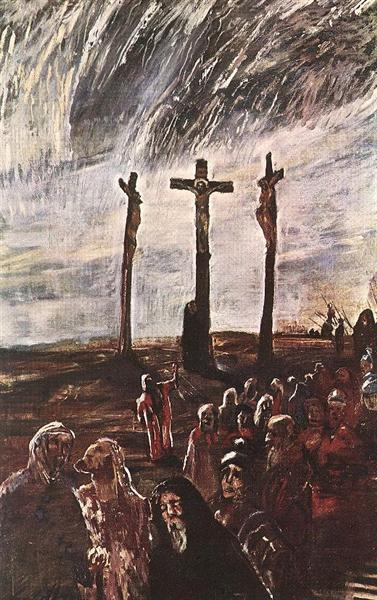Description
The painting "Gólgota - 1912" by Lajos Gulámsy is a work that stands out for its deep symbolism and the emotional burden it transmits. Gulámsy, a Hungarian artist who lived during the nineteenth to the twentieth century transition, is characterized by his unique style that fuses elements of symbolism and modernism, a combination that manifests itself sublime in this piece.
"Golgotá" represents a crucial moment in the biblical narrative: the crucifixion of Christ in the Mount Gólgota. However, Gulámsy, in his traditional interpretive style, offers us a vision that is not literal, but rather introspective and abstract. The scene is impregnated with a grief atmosphere, which transcends the mere representation of the historical fact to enter the field of spiritual and the mystical.
One of the most notable aspects of the work is its color palette. Gulámsy uses dark and off tones, which emphasizes the sense of tragedy and solemnity. Brown, green and gray nuances combine to create a gloomy and almost spectral environment. These colors not only serve to reflect the pain of the event, but also to transmit the artist's inner mood, marked by melancholy and suffering.
The artistic composition of "Golgota" is equally significant. In the center of the painting, a central figure, presumably Christ, stands on the bottom, although Gulámsy opts for a less conventional and more suggestive representation. Unlike the iconic images of the crucifixion we know, the Christ of Gulámsy is surrounded by blurry, almost ghostly forms and figures, which can be interpreted as souls in penalty or representations of the multitude of the golgotha. The choice not to clearly define the characters adds a feeling of disorientation and mystery that surrounds the viewer.
Another aspect worth mention is the texture of painting. Gulácsy's technique, with loose and sometimes abrupt brushstrokes, contributes to the feeling of movement and dynamism, despite the apparent stillness of the scene. This movement can be understood as a representation of the time that advances, inevitably, towards the fulfillment of the fatal destination of the central figure.
In historical and contextual terms, it is important to consider that "Gólgota - 1912" is created in a period of European agitation, shortly before the outbreak of the First World War. Gulámsy himself lived a life full of personal difficulties, including mental health problems, which undoubtedly influenced his artistic approach. "Gólgota" can then be interpreted not only as a representation of a religious event, but also as a metaphor of universal sacrifice and human suffering, issues that deeply resonated in the socio -political context of their time.
In the trajectory of Hungarian and European art, the work of Lajos Gulámsy occupies a unique place. Artists like him, who dared to explore the darkest and most mysterious corners of the human spirit, established paths for introspection and individual expression in modern art. "Gólgoota - 1912", with its mixture of symbolism and modernism, its colorful umbrella and its suggestive composition, remains an evocative piece that invites us to reflect on the multiple layers of suffering and redemption.
KUADROS ©, a famous paint on your wall.
Hand-made oil painting reproductions, with the quality of professional artists and the distinctive seal of KUADROS ©.
Art reproduction service with satisfaction guarantee. If you are not completely satisfied with the replica of your painting, we refund your money 100%.

